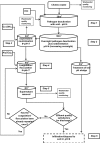Minimizing the Risk of Disease Transmission in Emergency Settings: Novel In Situ Physico-Chemical Disinfection of Pathogen-Laden Hospital Wastewaters
- PMID: 26110821
- PMCID: PMC4482504
- DOI: 10.1371/journal.pntd.0003776
Minimizing the Risk of Disease Transmission in Emergency Settings: Novel In Situ Physico-Chemical Disinfection of Pathogen-Laden Hospital Wastewaters
Abstract
The operation of a health care facility, such as a cholera or Ebola treatment center in an emergency setting, results in the production of pathogen-laden wastewaters that may potentially lead to onward transmission of the disease. The research presented here evaluated the design and operation of a novel treatment system, successfully used by Médecins Sans Frontières in Haiti to disinfect CTC wastewaters in situ, eliminating the need for road haulage and disposal of the waste to a poorly-managed hazardous waste facility, thereby providing an effective barrier to disease transmission through a novel but simple sanitary intervention. The physico-chemical protocols eventually successfully treated over 600 m3 of wastewater, achieving coagulation/flocculation and disinfection by exposure to high pH (Protocol A) and low pH (Protocol B) environments, using thermotolerant coliforms as a disinfection efficacy index. In Protocol A, the addition of hydrated lime resulted in wastewater disinfection and coagulation/flocculation of suspended solids. In Protocol B, disinfection was achieved by the addition of hydrochloric acid, followed by pH neutralization and coagulation/flocculation of suspended solids using aluminum sulfate. Removal rates achieved were: COD >99%; suspended solids >90%; turbidity >90% and thermotolerant coliforms >99.9%. The proposed approach is the first known successful attempt to disinfect wastewater in a disease outbreak setting without resorting to the alternative, untested, approach of 'super chlorination' which, it has been suggested, may not consistently achieve adequate disinfection. A basic analysis of costs demonstrated a significant saving in reagent costs compared with the less reliable approach of super-chlorination. The proposed approach to in situ sanitation in cholera treatment centers and other disease outbreak settings represents a timely response to a UN call for onsite disinfection of wastewaters generated in such emergencies, and the 'Coalition for Cholera Prevention and Control' recently highlighted the research as meriting serious consideration and further study. Further applications of the method to other emergency settings are being actively explored by the authors through discussion with the World Health Organization with regards to the ongoing Ebola outbreak in West Africa, and with the UK-based NGO Oxfam with regards to excreta-borne disease management in the Philippines and Myanmar, as a component of post-disaster incremental improvements to local sanitation chains.
Conflict of interest statement
The authors have declared that no competing interests exist.
Figures
Similar articles
-
A bioassay-based protocol for chemical neutralization of human faecal wastes treated by physico-chemical disinfection processes: A case study on benzalkonium chloride.Int J Hyg Environ Health. 2019 Mar;222(2):155-167. doi: 10.1016/j.ijheh.2018.07.002. Epub 2018 Nov 10. Int J Hyg Environ Health. 2019. PMID: 30424942 Free PMC article.
-
Assessment of recommended approaches for containment and safe handling of human excreta in emergency settings.PLoS One. 2018 Jul 26;13(7):e0201344. doi: 10.1371/journal.pone.0201344. eCollection 2018. PLoS One. 2018. PMID: 30048542 Free PMC article.
-
Uptake of household disinfection kits as an additional measure in response to a cholera outbreak in urban areas of Haiti.J Water Health. 2013 Dec;11(4):623-8. doi: 10.2166/wh.2013.050. J Water Health. 2013. PMID: 24334836
-
Upflow anaerobic sludge blanket reactor--a review.Indian J Environ Health. 2001 Apr;43(2):1-82. Indian J Environ Health. 2001. PMID: 12397675 Review.
-
Characterization of Interventional Studies of the Cholera Epidemic in Haiti.Prehosp Disaster Med. 2018 Apr;33(2):176-181. doi: 10.1017/S1049023X17007002. Epub 2018 Feb 19. Prehosp Disaster Med. 2018. PMID: 29455682 Review.
Cited by
-
Disinfection of Ebola Virus in Sterilized Municipal Wastewater.PLoS Negl Trop Dis. 2017 Feb 1;11(2):e0005299. doi: 10.1371/journal.pntd.0005299. eCollection 2017 Feb. PLoS Negl Trop Dis. 2017. PMID: 28146555 Free PMC article.
-
A bioassay-based protocol for chemical neutralization of human faecal wastes treated by physico-chemical disinfection processes: A case study on benzalkonium chloride.Int J Hyg Environ Health. 2019 Mar;222(2):155-167. doi: 10.1016/j.ijheh.2018.07.002. Epub 2018 Nov 10. Int J Hyg Environ Health. 2019. PMID: 30424942 Free PMC article.
-
Assessment of recommended approaches for containment and safe handling of human excreta in emergency settings.PLoS One. 2018 Jul 26;13(7):e0201344. doi: 10.1371/journal.pone.0201344. eCollection 2018. PLoS One. 2018. PMID: 30048542 Free PMC article.
-
Persistence of Ebola Virus in Sterilized Wastewater.Environ Sci Technol Lett. 2015 Sep 8;2(9):245-249. doi: 10.1021/acs.estlett.5b00193. Epub 2015 Aug 17. Environ Sci Technol Lett. 2015. PMID: 26523283 Free PMC article.
-
A Systematic Review and Meta-Analysis of the Association between Water, Sanitation, and Hygiene Exposures and Cholera in Case-Control Studies.Am J Trop Med Hyg. 2018 Aug;99(2):534-545. doi: 10.4269/ajtmh.17-0897. Epub 2018 Jun 28. Am J Trop Med Hyg. 2018. PMID: 29968551 Free PMC article.
References
-
- Adams P (2013) Cholera in Haiti takes a turn for the worse. Lancet 381: 1264–1264. - PubMed
-
- MSPP (2014) Rapport de cas Port-au-Prince: MSPP.
-
- Global Task Force on Cholera Control (1993) Guidelines for cholera control Geneva, Switzerland: World Health Organization.
-
- Sack DA, Sack RB, Nair GB, Siddique AK (2004) Cholera. Lancet 363: 223–233. - PubMed
-
- Bourdelais P, Dodin A. (1987) Visages du cholera Paris, France: Editions Belin.
Publication types
MeSH terms
Substances
LinkOut - more resources
Full Text Sources
Other Literature Sources
Medical
Research Materials
Miscellaneous



